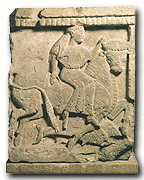During the Archaic period the most important type of architecture was the sacral. Thus, the sculptured decoration of buildings is mostly met in temples, treasuries and altars. Only towards the end of the period, did the secular buildings start to compet the ascral ones. The development of the two architectural orders, Doric
and Ionic,
in the second half of the 7th century B.C. associated the use of architectural sculpture with specific parts of the temple. Of course there are some examples from earlier buildings in Crete, but there the architectural decoration does not follow the rules of the forementioned orders. For example, in the temple of Prinias, two seated figures -almost fully sculptured- are situated over a frieze with a repetitive theme.
In the Doric order the metopes -which formerly were painted- have relief representations, whereas the triangular pediment was initially decorated with relief figures and later with fully sculptured narrative ensembles. On the contrary, in the Ionic order, the pediment with decorative and later with narrative context prevailed. Furthermore, quite often the columns had relief figures and the capitals bore busts of animals or mythological beings. Generally, the use of sculptures in the Ionic order is less predetermined than in the Doric. The columns of the prostasis at some point are replaced by female forms (caryatids),
an innovation of clearly oriental origin. In both architectural orders the angles of the pediment (acroteria) are decorated with fully sculptured figures, whereas human or animal heads cover the gutters around the roof (antefixes and gutters). These parts in earlier temples were made of clay. |
 |















